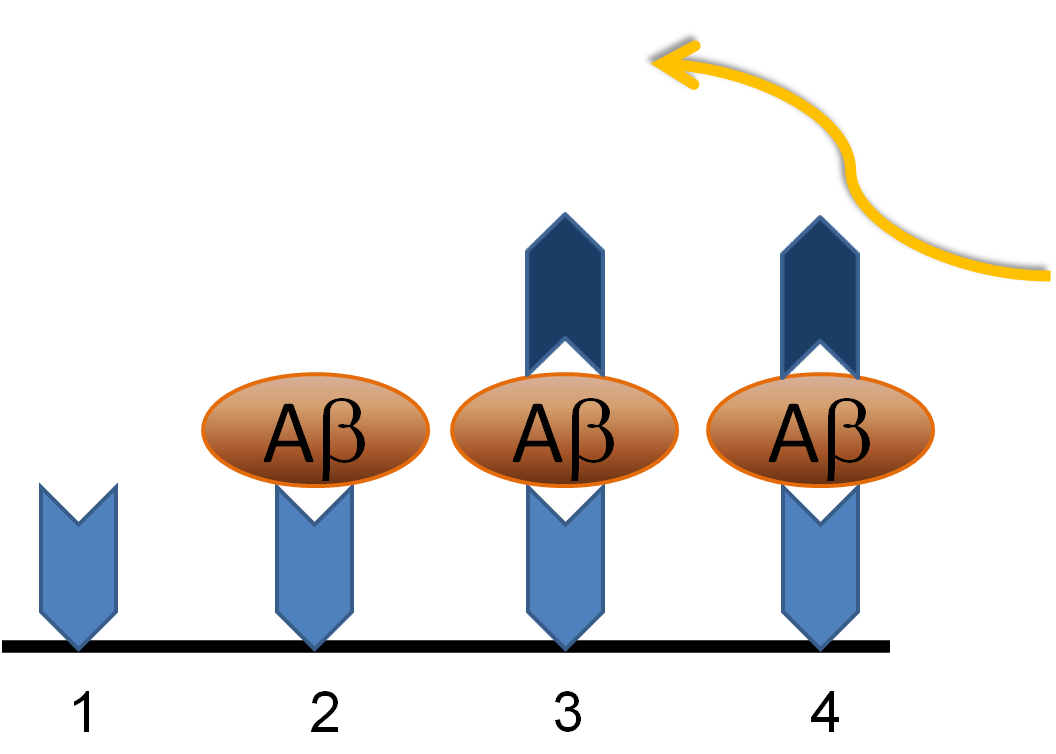ELISA Kits for Amyloid Synthesis Pathways (2X96T)
Click to enlarge |
|
|
Price (USD) |
Number of Kits |
Number of Assays |
|---|---|---|
|
$1150.00 |
2 |
2x96T (192) |
|
Part No. |
Description |
Dectection Range |
Stnd Peptide |
| hAB1-40 ELISA |
50pg - 4ng/ml |
3.6ng/ml
|
|
| hAB1-42 ELISA |
10 - 470pg/ml |
450pg/ml | |
|
hsynuclein ELISA |
10 - 470pg/ml |
450pg/ml |
|
|
cAB1-42 ELISA |
Canine Amyloid-Beta 1-42 ELISA Kit |
10 - 470pg/ml |
450pg/ml |
|
cAB1-40
ELISA |
Canine Amyloid-Beta 1-40 ELISA Kit |
50pg - 4ng/ml |
3.6ng/ml |
| hE2 ELISA | Human E2-UBCE ELISA kit |
50 - 900 microg/L |
1200 microg/L |
| hTE-ELISA | Human Telomerase, TE ELISA kit |
35 - 1200 microg/L |
1400 microg/L |
 Steps of Sandwich ELISA
Steps of Sandwich ELISA1. Equilibrate plate to ambient temperature
Sandwich ELISA Method Overview
Background on Protein Targets of the Amyloid ELISA Kits
Amyloid-Beta: Amyloid-Beta (Aβ) is generated by sequential cleavage by alpha, beta and gamma secretases of the amyloid precursor protein (APP), a transmembrane protein of unknown function. Inhibition of secretase activity has been proposed as a therapeutic strategy to limit amyloid-Beta (Aβ) accumulation. The γ secretase, which produces the C-terminal end of the Aβ peptide, cleaves within the transmembrane region of APP and generates amyloid-Beta (Aβ) isoforms of 36-43 amino acid residues in length. The most common isoforms of amyloid-Beta are Aβ40 and Aβ42; the shorter amyloid-Beta isoform is typically produced by cleavage in the endoplasmic reticulum, while the longer isoform is processed by cleavage in the trans-Golgi network. Aβ40 is the most common amyloid-Beta (Aβ) isoform, but Aβ42 is the more fibrillogenic and is thus is the predominant form associated Alzheimer’s disease. Antibodies employed in this Amyloid-Beta ELISA kit are selective for the Aβ42 isoform of amyloid-beta, with insignificant cross-reactivity with the Aβ40 isoform.
Alpha-Synuclein: Alpha-synuclein (SNCA gene) is a 140 amino acid predominantly cytosolic protein expressed in brain and associated with fibrillar structures in Lewy Bodies associated with Parkinson’s disease. Although primary located in the cytosol, alpha-synuclein binds to phospholipid and is associated with cellular membraneous structures. Generation of aggregates in Lewy Bodies and/or association of alpha-synuclein with membraneous structures has been attributed to the etiology of Parkinson’s Disease.
Defects in SNCA are the cause of Parkinson disease type 1 (PARK1). A complex neurodegenerative disorder characterized by bradykinesia, resting tremor, muscular rigidity and postural instability. Additional features are characteristic postural abnormalities, dysautonomia, dystonic cramps, and dementia. The pathology of Parkinson disease involves the loss of dopaminergic neurons in the substantia nigra and the presence of Lewy bodies (intraneuronal accumulations of aggregated proteins), in surviving neurons in various areas of the brain.
E2-UBCE. Ubiquitin Conjugating Enzyme: Ubiquitin-conjugating enzymes, or E2 operate in the second step in the ubiquitination reaction that adds ubiquitin subunits to lysines and results in targeting a protein for degradation in the proteasome. The polyubiquitination process covalently attaches multiple chains of ubiquitin, a 76 amino acids peptide, to lysine residue on the target protein. Once a protein has been tagged with polyubiquitin, it is recognized by the proteasome's 19S subunit, which triggers the ATP-dependent unfolding and targeting into the proteasome's 20S core particle, where proteolysis takes place.
 Products
Products Manuals
Manuals
